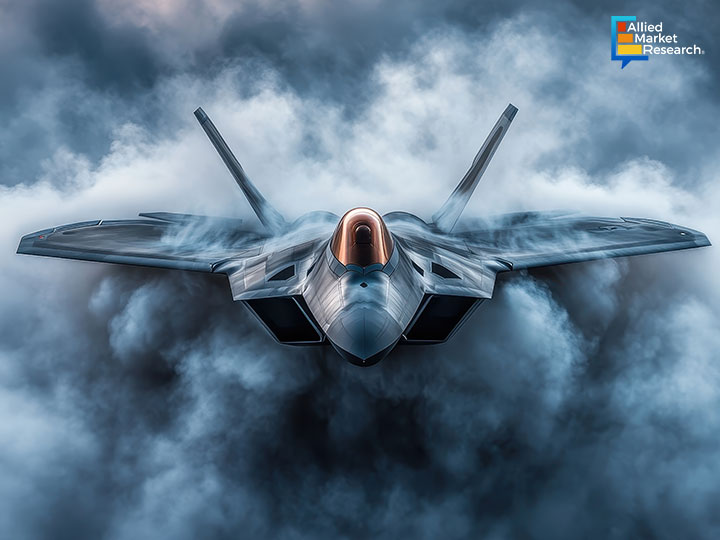Breakthroughs in Stealth Technology: Redefining Modern Warfare

9 Jul
2025
Highlights:
- Next-gen materials transforming stealth capabilities
- Evolving designs in stealth technology
- AI in revolutionizing stealth
Stealth technology, also known as low-observable technology, is a collection of techniques and designs used to make military vehicles, aircraft, ships, and missiles less detectable by radar, infrared sensors, sonar, and other detection systems. This technology aims to enhance the survivability of these assets by making them harder to detect, track, and target.
Advanced materials and coatings shaping the future of stealth technology
The stealth technology industry has witnessed prominent growth due to significant material innovations. Modern stealth platforms rely heavily on radar-absorbing materials to absorb and dissipate radar energy, preventing reflection back to enemy sensors. Aircraft like the F-22 Raptor and B-2 Spirit utilize specialized coatings that convert radar waves into heat, significantly lowering their detectability. Recently, Russian innovations have brought out a new material based on metal-core glass filaments, capable of absorbing up to 95% of incident electromagnetic radiation. Unlike traditional coatings that require frequent maintenance, this material is durable and suitable for high-visibility components like engine compressor blades.
Furthermore, nanotechnology enables the creation of surfaces that scatter radar waves at the molecular level, while metamaterials absorb electromagnetic waves in unconventional ways. These breakthroughs are leading to the development of adaptive, lightweight, and highly effective stealth coatings for a range of military platforms.
Stealth technology also addresses infrared and acoustic signatures, apart from radar. Low-emissivity materials and heat-dissipating exhaust systems reduce the heat footprint of aircraft and vehicles, making them harder to detect with thermal imaging. In submarines, noise reduction is achieved through advanced propeller designs, vibration isolation, and sound-absorbing hull materials to minimize detection by sonar.
Innovations in aircraft and submarine stealth
In the past few years, the rise of the U.S. Air Force’s B-21 Raider has showcased a notable innovation in stealth aviation. It has become the world’s first aircraft with sixth-generation characteristics. The B-21 incorporates a smooth exterior, optimized air intake, and specially shaped windows to reduce its radar cross-section. These design refinements, combined with the integration of unmanned flight modes and advanced standoff weapons, enable the B-21 to penetrate heavily defended airspace and evade detection more efficiently than its predecessors.
Similarly, the underwater Type-039C Yuan-class submarine of China exemplifies cutting-edge stealth. Its uniquely angled sail deflects sonar signals, reducing its acoustic signature and enhancing survivability.
AI-enabled platforms redefine stealth operations
Artificial intelligence and machine learning are revolutionizing stealth technology by enabling platforms to adapt dynamically to changing threats. AI systems analyze sensor data in real time, allowing aircraft, ships, and vehicles to automatically adjust their stealth profiles. These profiles include radar absorbency, heat emission, and electronic countermeasures, based on the surrounding environment. This intelligent situational awareness helps platforms evade detection by autonomously modifying their signatures, and deactivating jamming systems as needed. AI integration maximizes survivability and mission effectiveness, ensuring stealth assets remain elusive even against advanced and adaptive enemy detection systems.
NIT Rourkela and DRDO joined hands to boost submarine stealth technology
In February 2025, NIT Rourkela and DRDO collaborated on a groundbreaking project to develop advanced underwater tiles that enhance submarine stealth. These tiles aim to reduce sonar detectability by absorbing or scattering sound waves, helping submarines remain undetected. The initiative supports the self-reliant defense capabilities of India and also benefits sectors like marine research and oil exploration. Under this agreement, researchers have started testing small-scale tiles in water-filled cylindrical devices to evaluate their acoustic performance and effectiveness.
The bottom line
The evolution of stealth technology is driven by next-generation materials, intelligent systems, and integrated platforms. These innovations enhance multi-domain survivability, enabling platforms to operate undetected across air, sea, and land. Moreover, with ongoing research and global adoption, stealth is expected to become smarter, more resilient, and integral to modern military strategy.
To gain more insights into the latest advancements in the stealth technology sector, feel free to talk to our industry specialists today!

Koyel Ghosh
Author’s Bio- Koyel Ghosh is a blogger with a strong passion and enjoys writing in miscellaneous domains, as she believes it lets her explore a wide variety of niches. She has an innate interest in creativity and enjoys experimenting with different writing styles. A writer who never stops imagining, she has been serving the corporate industry for the last five years.
Avenue: Entire Library membership of Allied Market Research Reports at your disposal
- Avenue is an innovative subscription-based online report database.
- Avail an online access to the entire library of syndicated reports on more than 2,000 niche industries and company profiles on more than 12,000 firms across 11 domains.
- A cost-effective model tailored for entrepreneurs, investors, and students & researchers at universities.
- Request customizations, suggest new reports, and avail analyst support as per your requirements.
- Get an access to the library of reports at any time from any device and anywhere.
Related Post
-
How are Submarine Cables Transforming Global Connectivity with Enhanced User Experience?
-
Endoscopy Procedures: Transformations in Techniques and Applications
-
AI-Powered Video Analytics: How the Product Actually Works for enterprises
-
Painting Robots: Transforming Precision Coating and Creative Applications
-
Innovations in Pharmacovigilance Systems Advancing Patient Safety
-
Understanding Edge Security: Keeping Data Safe Near the Source
-
Exploring the Use and Advancements of 3D Laser Scanners in Professional Applications
-
Reinforcing Industrial Controls with Smarter Tools and Training








